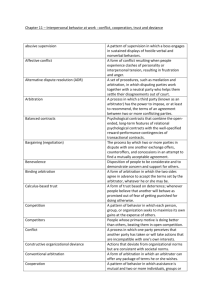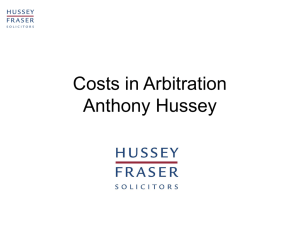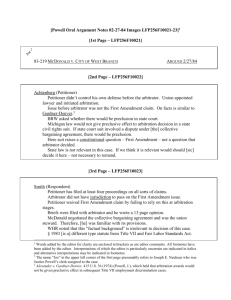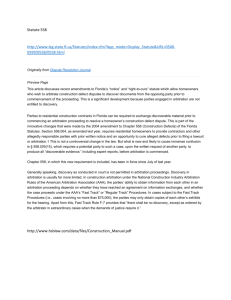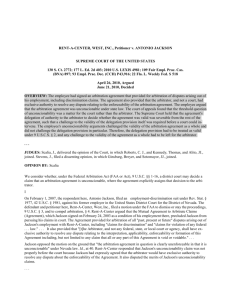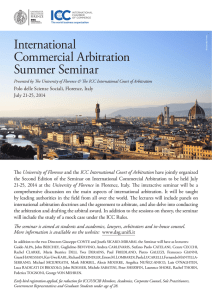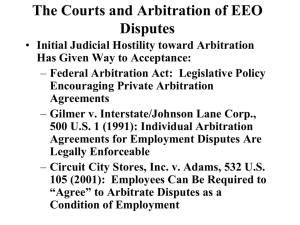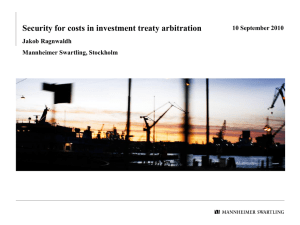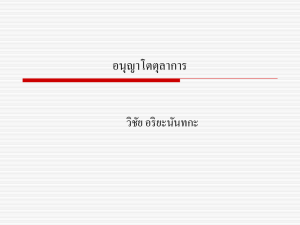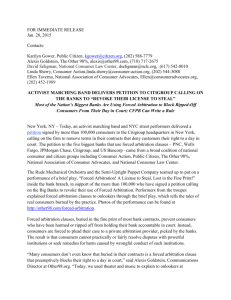Talk by Hew Dundas - slides
advertisement
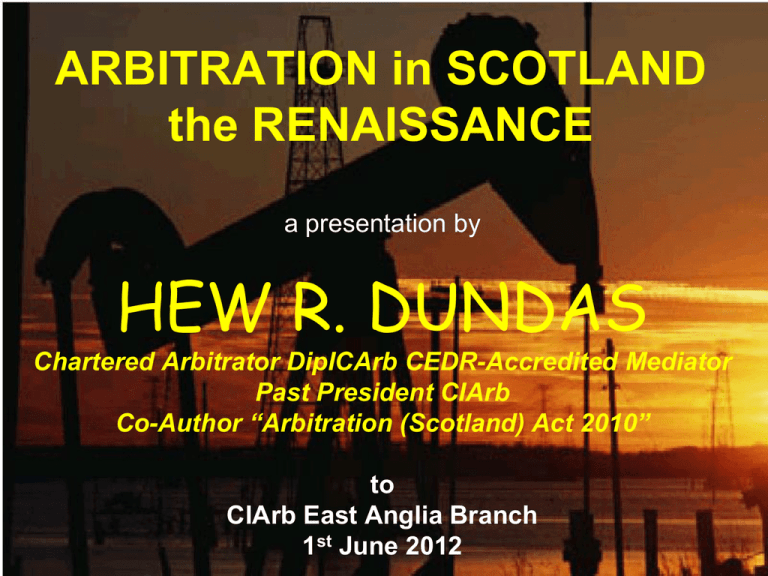
ARBITRATION in SCOTLAND the RENAISSANCE a presentation by HEW R. DUNDAS Chartered Arbitrator DipICArb CEDR-Accredited Mediator Past President CIArb Co-Author “Arbitration (Scotland) Act 2010” to CIArb East Anglia Branch 1st June 2012 OVERVIEW of PRESENTATION Introduction The History Attempts at Reform 1985-2008 The 2008/09 Bill The 2010 Act Alternative to Adjudication ? Conclusions HISTORY of ARBITRATION in SCOTLAND Ancient Origins Cambuskenneth Abbey v Dunfermline Abbey (1207) Regiam Majestatem c.1300 Legislative History Acts of 1598, 1695, 1894 Administration of Justice (Scotland) Act 1972 Law Reform (Miscellaneous Provisions) (Scotland) Act 1990 The 2002 Bill – CIArb + others DEFICIENCIES in OLD LAW (1) No concept of severability Kompetenz-Kompetenz rejected Caledonian Railway (1872) No inherent/implied power to award damages, expenses or interest Stated Case Procedure S.3 Administration of Justice (Scotland) Act 1972 Unclear whether Court Rules of Evidence applied DEFICIENCIES in OLD LAW (2) No slip rule; No provision regarding privacy or confidentiality No provision for partial or interim awards Immunity of arbitrators unclear A Party can be the [sole] arbiter Inaccessibility of the law Reliance on a Clerk Reliance on ancient authority UNCITRAL & the MODEL LAW Origins New York Convention 1958 Why UNCITRAL exists UNCITRAL Rules 1976, revised 2010 Model Law 1985, revised 2006 S.26 of the 2010 Act Repeal of the 1990 legislation Fundamentally flawed THE 2009 BILL Consultation process June-Dec. 2008 Consultation draft September 2008 Bill published 30th January 2009 Parliamentary Process Stages 1/2/3 Hearings CIArb submissions – 42,000 words Parliament Approves 18th November 2009 Royal Assent 5th January 2010 The ACT: MAIN FEATURES (1) Single integrated Act compare Ireland/Singapore/NZ et al UNCITRAL Model Law compliant Unprecedentedly extensive international research International Best Practice – UNCITRAL Rules 2010 and s.26 Procedural Rules in Schedule 1 The ACT: MAIN FEATURES (2) Easy-to-use structure – Part 1, Part 2 etc User-friendly explanatory Rules Mandatory and Default Rules Mandatory – fundamental principles which cannot be modified or discarded Default – can be modified/deleted, otherwise applicable; no vacuum Role of the Arbitration Agreement Death of the Submission Agreement The ACT: MAIN FEATURES (3) “Consumer” Arbitration ss.89-91 AA96 SSFARs to £25,000 (indicative upper limit) Transitional Provisions Arbitration Acts 1889, 1934, 1950, 1979, 1996 Dinosaurs Still Live !!! Retain Old Law in Perpetuity >5 year period KEY IMPROVEMENTS (1) Role of the Courts reduced to bare minimum First instance judgment “more final” No appeal from any decision by Sheriff Almost no access to Inner House NO appeal AT ALL to UK Supreme Court BUT court will support where necessary Law governing Arbitration Agreement (s.6) Oral arbitration agreements included Arbitrator to be an individual (Rule 3M) KEY IMPROVEMENTS (2) Resignation of Arbitrator (Rule 15M) Immunity Issue (R16M) Anonymity in Legal Proceedings (s.15) Confidentiality (Rule 26D) Parties can opt out e.g. Public Authorities Independence of Arbitrator (Rule 8M) AARs (s.22/Rule 7M) CIArb/RICS/LSoS/FoA + others KEY IMPROVEMENTS (3) “Dermajaya” provision (s.32(1)) Gannet v Eastrade (Rule 58(7)(b) - D) Cetelem v Roust (Rule 46(4)(b) - D) Simplified Language of the Act Arbiter, oversman, decree arbitral – all gone Sist, expenses Economy “Plain English” Policy User-friendly approach COMPARISON with the 1996 ACT Reduced Role of the Court AARs (s.22/R7M) Disclosure of Conflicts (Rule 8M) Resignation of Arbitrator (R15M) Confidentiality (Rule 26D) Gannet/Cetelem (R46D/58D) Language/Style RECOMMENDED READING ARBITRATION (SCOTLAND) ACT 2010 by Fraser Davidson, Hew R Dundas & David Bartos Pub. W Green & Co (Edinburgh) 2010 ISBN 978-0-414-017772-6 Published Same Day as Act Came into Force The Arbitration (Scotland) Act 2010: Converting Vision into Reality [2010] 76 ARBITRATION 2 at p.15 See also [2004] 70 ARBITRATION 2 ALTERNATIVE to ADJUDICATION ? Arbitrator control of proceedings e.g. R28D More detailed process R28-R40 Court Support R45M+46D Wider range of tools e.g. R41D+42M Finality Enforceability CONCLUSIONS THANK YOU for listening to me this morning
